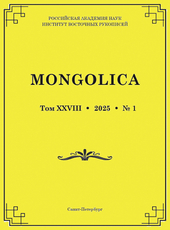
|
Mongolica. Vol. XXVIII, No. 1 / Ed. by I. V. Kulganek (editor-in-chief), D. A. Nosov (secretary), M. A. Kozintcev (deputy secretary). St Petersburg, 2025. 44 p. ISSN 2311-5939.
M. Petrova. 70th Birthday of Vladimir L. Uspensky, Professor of the Department of Mongolian Studies and Tibetology of The Faculty of Asian and African Studies at the St. Petersburg State University — 5
PHILOLOGY
O. Bavaeva. “The Song of the Stormy Petrel” by Maxim Gorky Translated into the Kalmyk Language — 8
The article analyses the translation of Maxim Gorky’s poem “The Song of the Stormy Petrel” into the Kalmyk language made by Hasr San-Belgin, the prominent poet of the 20th century. The stylistic and semantic analysis has revealed the methods used by the translator to transfer the meaning and emotions of the original text. The translator often makes use of structural, grammatical transformations to convey the ideas of the original version. The difference between Russian and Kalmyk languages and culture often entails pragmatic adaptation, lexical additions, and sometimes complete lexical transformation of some parts.
Keywords: Hasr San-Belgin, structural transformation, metonymic transformation, pragmatic adaptation, lexical transformation.
B. Dayriimaa. Manifestation of Family Relations in Mongolian Non-fairy Tales — 13
Mongolian folk tales, regardless of their genre features, reflect various social phenomena. In some cases, they contain hidden meaning. This is mainly observed in animal tales and satirical non-fairy tales. In addition, in non-fairy tales it is also expressed both in the direct sense and in a hidden, symbolic form. One of the many themes reflected in folk tales is the theme of family. The plot in such tales is based on elements containing moral values. They are often expressed in fairy tales with symbolic and hidden meaning.
Keywords: Mogolian folklore, reflection, social institution, stereotypes, symbols, moral values.
HISTORY. CULTURE
G. Batdorj, B. Batjargal. Topical Issues of Military Musical Training Methodology in Mongolia — 18
This article is devoted to the issues of military musical training methodology in Mongolia. The authors, examining the history of the development of Mongolian military musical education of the Western type, believe that this process began during the formation of the Autonomous Mongolia (1911). It was then that Mongolia launched a policy of gradual withdrawal from the spiritual influence of India, Tibet, Manchuria and for the first time accepted Western culture as “artistic”, opening its doors to it. The introduction of the fundamentals of Western art education at the state level began with the opening of the School of Fine Arts in Ulaanbaatar in 1937. The second art educational institution of the Western type in Mongolia was the Circus School, organized in 1940. The article analyzes in detail the pedagogical and educational activities of Russian and Soviet trainers, such as K .V. Kadlec, A. Koltsov, B. F. Smirnov, G. A. Uvarova, directors V. A. Boreysho and A. A. Efremov, and others, who were sent to Mongolia in the 1930s to 1950s to help the fraternal people in cultural development. The authors also pay attention to the activities of the first Mongolian graduates of a Western conservatory — composer S. Gonchigsumla (P. I. Tchaikovsky Conservatory in Moscow, USSR, 1952) and opera singer G. Khaidav (P. I. Tchaikovsky Conservatory in Moscow, USSR, 1954). In the period after the democratic revolution (1990–2023), the Military Music Polytechnic College was established in Ulaanbaatar to train military musicians. The article provides a detailed analysis of the curriculum, work programs and teaching methods of this educational institution.
Keywords: Mongolia, military music training, methodology, musical education in Mongolia.
V. Zhukov. At Whose Expense was the Buddhist Temple «Datsan Gunzechoinei» in St. Petersburg Built (1909–1915)? An Attempt at Historical Financial Audit — 29
The purpose and topic of the article as indicated in its title, is to establish who — Russia, Mongolia or Tibet — contributed the largest share of funds (and what approximate amount) to the construction of the Buddhist temple in St. Petersburg at the turn of the first two decades of the 20th century. This is an example of how modernity needs historical proceedings. On the one hand, these would seem to be the affairs of bygone days. More than a century has passed since then. On the other hand, the question itself is far from idle and not at all purely confessional. Among other things it is quite relevant today in terms of international relations. An attempt to make this matter clear indicates that the Russian (Tsarist) government allocated more than 3/4 of the money for the construction and interior decoration of the Buddhist temple in the capital of the Russian Empire.
Keywords: «Datsan Gunzechoinei», Russia, Mongolia, Tibet, funds, share, construction.
ACADEMIC LIFE
I. Boltach, I. Kulganek. The 13th St. Petersburg Seminar of Tibetan Studies Dedicated to the 300th Anniversary of the Russian Academy of Sciences (St. Petersburg, IOM RAS, November 13–14, 2024) — 37
 PDF-files PDF-files
Full text
Keywords
|

